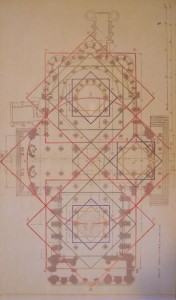scored for orchestra (3333.4331.timp+3.hrp.pno.strings)
duration 10 minutes
During my last years at USC I was in the habit of poking around the Art and Architecture Library for things that might spark my imagination. I found this picture— a plan for Chartres Cathedral overlaid with various colored lines— in a slim volume called Gothic Cathedrals and Sacred Geometry by George Lesser. I knew right off I had the makings of a new project.
Lesser spent his life measuring medieval churches and hypothesizing on the systems of proportion their builders used to endow the structures with pleasing forms and spiritual significance. I’ve long been drawn to the idea that musical proportions can carry meaning— an idea not unfamiliar to composers of many different periods— and the image in Lesser’s text was the perfect starting point for exploring this idea.
My piece can be heard as a programmatic journey from one end of Chartres Cathedral to the other. It starts with the massive Western façade and moves in and through the structure, passing over three significant points that divide Lesser’s rendering— and also the form of my composition— into four equal parts.
My piece is also an experiment in the use of systems to control the composition process. The last half of the music unfolds through a rigorous set of rules, not unlike the unseen geometries that govern Lesser’s reading of architectural form. The placement of every note is determined by a (mostly) inaudible cycle of chords rotating around the circle of fifths. The result of all this rule-bound composition is one of the most spacious and openly emotive spans of music I’ve ever written. Realizing, as I did here, that systematized composition could be useful in achieving a wide range of expressive goals was an important step for me and my music.
Sacred Geometry was commissioned by the New York Youth Symphony and premiered at Carnegie Hall on December 7, 2003. It was the recipient of the ASCAP Nissim Prize as well as the Aspen Music Festival Druckman Prize, and it was read by the Minnesota Orchestra at their Composers’ Institute in 2004.

